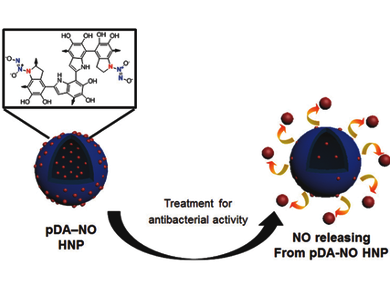Gram-negative bacteria with multidrug resistance dramatically increased around the globe and novel antibiotics are urgently needed. Novel treatments include the use of the endogenous gas nitric oxide. NO as well as the NO radical, its byproducts including peroxynitrite, and dinitrogen trioxide show antibacterial effects on various bacterial species by the induction of oxidative and nitrosative stress by lipid peroxidation and membrane rupture.
Dongsik Park, Institute of Basic Science, Pohang, South Korea, and colleagues investigate NO delivery systems using a NO donor with a functional moiety capable of generating NO. The team uses diazeniumdiolate-functionalized polydopamine hollow nanoparticles (pDA-NO HNPs) for the antibacterial application. First, silica nonoparticles are synthesized as a template for the hollow nanostructures. Dopamine is polymerized on the surface and subsequently the silica elements are eliminated. By exposing the pDA HNPs to NO, diazeniumdiolates form as verified by FT-IR and XPS.
The NO release from the pDA-NO HNPs at physiological conditions is sufficient to induce an antibacterial effect by disruption of the membrane of the bacteria. Yet, pDA-NO HNPs only reveal negligible cytotoxicity on mammalian cells.
- Polydopamine Hollow Nanoparticle Functionalized withN-diazeniumdiolates as a Nitric Oxide Delivery Carrier for Antibacterial Therapy,
Dongsik Park, Jihoon Kim, Yeong Mi Lee, Junghong Park, Won Jong Kim,
Adv. Healthcare Mater. 2016.
DOI: 10.1002/adhm.201600150




